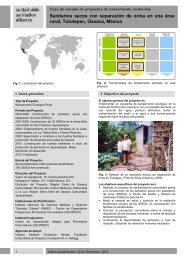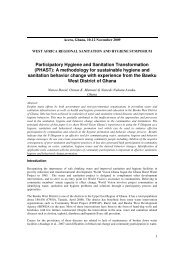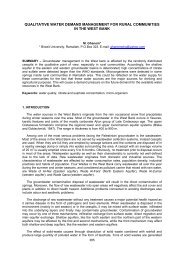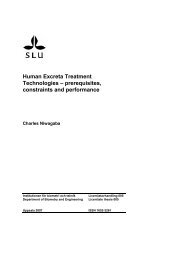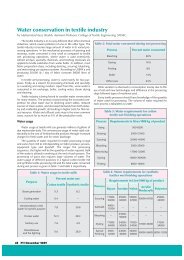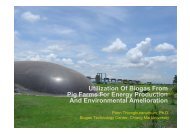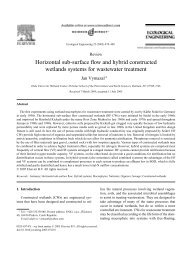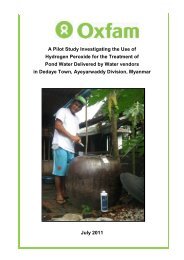Fertigation: Optimizing the Utilization of Water and Nutrients - SSWM
Fertigation: Optimizing the Utilization of Water and Nutrients - SSWM
Fertigation: Optimizing the Utilization of Water and Nutrients - SSWM
Create successful ePaper yourself
Turn your PDF publications into a flip-book with our unique Google optimized e-Paper software.
Nutrient movement<br />
Strongly sorbed ions, such as phosphate, are less mobile in soils than non-‐<br />
sorbed ions, such as nitrate or chloride (Kafkafi <strong>and</strong> Bar Yosef, 1980). During<br />
repeated fertigation cycles <strong>the</strong>re is a balance between <strong>the</strong> lateral spread <strong>of</strong> water<br />
<strong>and</strong> evaporation, as a result <strong>of</strong> which soluble salts might accumulate at <strong>the</strong><br />
border between <strong>the</strong> dry <strong>and</strong> <strong>the</strong> wet zones, especially in hot dry areas with no<br />
dry-‐season rainfall (Kafkafi <strong>and</strong> Bar Yosef, 1980). The salt accumulated at <strong>the</strong><br />
wet zone periphery can reach very high levels <strong>and</strong>, a single flush <strong>of</strong> rain could<br />
wash this salt into <strong>the</strong> root zone <strong>and</strong> cause considerable damage.<br />
Plastic covers<br />
To avoid soluble salt accumulation on <strong>the</strong> soil surface because <strong>of</strong> evaporation,<br />
irrigation under a plastic cover is used, especially when saline water is <strong>the</strong> only<br />
source for irrigation. In an arid climate zone, where <strong>the</strong> evaporation rate is high,<br />
mobile nutrient anions (NO3-‐, Cl-‐, ), toge<strong>the</strong>r with <strong>the</strong> cations Na+ <strong>and</strong> Ca2+ may<br />
accumulate around <strong>the</strong> wet zone periphery on <strong>the</strong> soil surface. This zone <strong>of</strong><br />
highly concentrated soluble salts is detrimental to young seedlings, because <strong>the</strong>ir<br />
restricted root system might be exposed to high salt concentrations, even with<br />
good-‐quality water.<br />
Selection <strong>of</strong> fertilizers<br />
Most water-‐soluble <strong>and</strong> liquid fertilizers are suitable for fertigation. In selecting<br />
a fertilizer four main factors should be taken into consideration.<br />
1.<br />
2.<br />
3.<br />
4.<br />
Plant type <strong>and</strong> stage <strong>of</strong> growth.<br />
Soil conditions.<br />
<strong>Water</strong> quality.<br />
Fertilizer composition <strong>and</strong> price.<br />
Type <strong>of</strong> plant<br />
Plant sensitivity to <strong>the</strong> form <strong>of</strong> N increases during <strong>the</strong> fruiting stages (Xu et al.,<br />
2001). Some plants, such as tomato, are very sensitive to high ammonium<br />
concentration near <strong>the</strong> roots, <strong>the</strong>refore, nitrate-‐rich nutrient solutions should be<br />
selected (Kafkafi et al., 1971).<br />
Soil <strong>and</strong> water conditions<br />
At elevated root-‐zone temperatures ammonium might damage <strong>the</strong> roots by<br />
competing with <strong>the</strong> sugar needed to root respiration. Local high ammonium<br />
15



